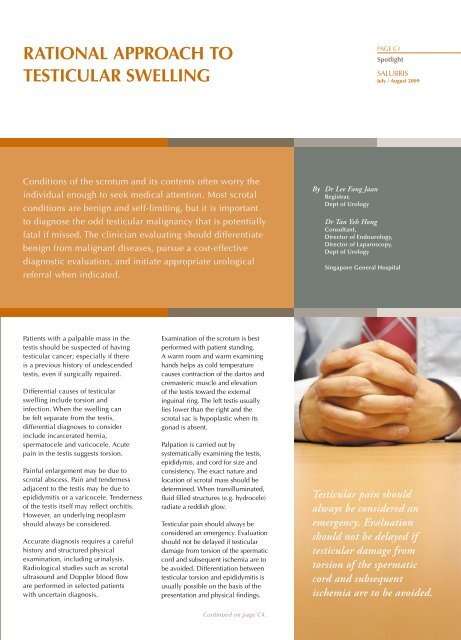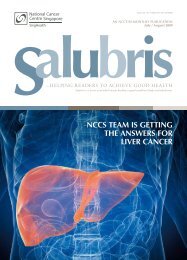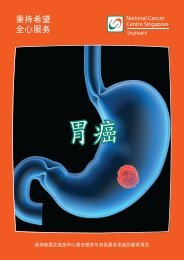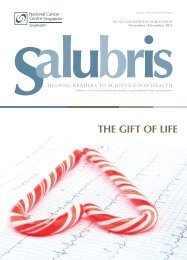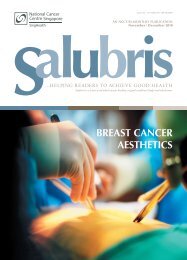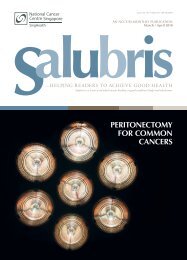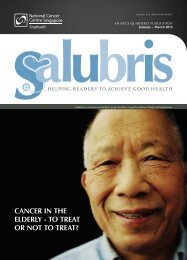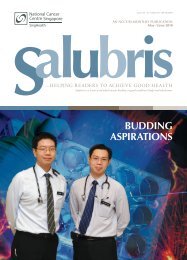Medical Professionals Version - National Cancer Centre Singapore
Medical Professionals Version - National Cancer Centre Singapore
Medical Professionals Version - National Cancer Centre Singapore
Create successful ePaper yourself
Turn your PDF publications into a flip-book with our unique Google optimized e-Paper software.
RATIONAL APPROACH TO<br />
TESTICULAR SWELLING<br />
PAGE C3<br />
Spotlight<br />
SALUBRIS<br />
July / August 2009<br />
Conditions of the scrotum and its contents often worry the<br />
individual enough to seek medical attention. Most scrotal<br />
conditions are benign and self-limiting, but it is important<br />
to diagnose the odd testicular malignancy that is potentially<br />
fatal if missed. The clinician evaluating should differentiate<br />
benign from malignant diseases, pursue a cost-effective<br />
diagnostic evaluation, and initiate appropriate urological<br />
referral when indicated.<br />
By Dr Lee Fang Jaan<br />
Registrar,<br />
Dept of Urology<br />
Dr Tan Yeh Hong<br />
Consultant,<br />
Director of Endourology,<br />
Director of Laparoscopy,<br />
Dept of Urology<br />
<strong>Singapore</strong> General Hospital<br />
Patients with a palpable mass in the<br />
testis should be suspected of having<br />
testicular cancer; especially if there<br />
is a previous history of undescended<br />
testis, even if surgically repaired.<br />
Differential causes of testicular<br />
swelling include torsion and<br />
infection. When the swelling can<br />
be felt separate from the testis,<br />
differential diagnoses to consider<br />
include incarcerated hernia,<br />
spermatocele and varicocele. Acute<br />
pain in the testis suggests torsion.<br />
Painful enlargement may be due to<br />
scrotal abscess. Pain and tenderness<br />
adjacent to the testis may be due to<br />
epididymitis or a varicocele. Tenderness<br />
of the testis itself may reflect orchitis.<br />
However, an underlying neoplasm<br />
should always be considered.<br />
Accurate diagnosis requires a careful<br />
history and structured physical<br />
examination, including urinalysis.<br />
Radiological studies such as scrotal<br />
ultrasound and Doppler blood flow<br />
are performed in selected patients<br />
with uncertain diagnosis.<br />
Examination of the scrotum is best<br />
performed with patient standing.<br />
A warm room and warm examining<br />
hands helps as cold temperature<br />
causes contraction of the dartos and<br />
cremasteric muscle and elevation<br />
of the testis toward the external<br />
inguinal ring. The left testis usually<br />
lies lower than the right and the<br />
scrotal sac is hypoplastic when its<br />
gonad is absent.<br />
Palpation is carried out by<br />
systematically examining the testis,<br />
epididymis, and cord for size and<br />
consistency. The exact nature and<br />
location of scrotal mass should be<br />
determined. When transilluminated,<br />
fluid filled structures (e.g. hydrocele)<br />
radiate a reddish glow.<br />
Testicular pain should always be<br />
considered an emergency. Evaluation<br />
should not be delayed if testicular<br />
damage from torsion of the spermatic<br />
cord and subsequent ischemia are to<br />
be avoided. Differentiation between<br />
testicular torsion and epididymitis is<br />
usually possible on the basis of the<br />
presentation and physical findings.<br />
Testicular pain should<br />
always be considered an<br />
emergency. Evaluation<br />
should not be delayed if<br />
testicular damage from<br />
torsion of the spermatic<br />
cord and subsequent<br />
ischemia are to be avoided.<br />
Continued on page C4.


